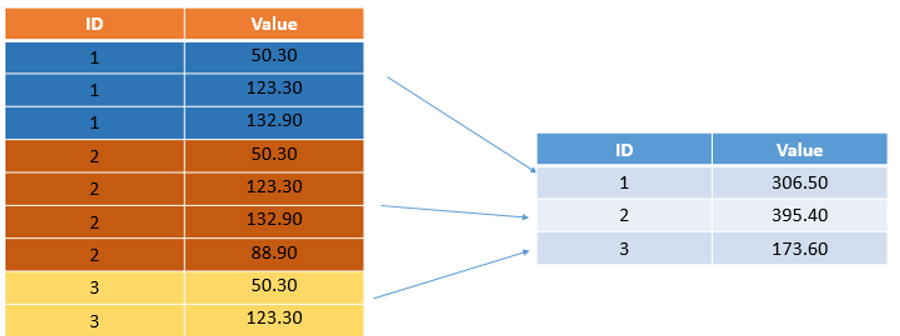Home »
Python
Pandas dataframe.groupby() Method
Python Pandas GroupBy | dataframe.groupby() Method: In this tutorial, we are going to learn about the Pandas GroupBy in Python with examples.
By Sapna Deraje Radhakrishna Last updated : August 24, 2023
Pandas dataframe.groupby() Method
Pandas dataframe.groupby() method can be used to work on group rows of data together and call aggregate functions. It allows to group together rows based off of a column and perform an aggregate function on them.
Syntax
DataFrame.groupby(
by=None,
axis=0,
level=None,
as_index=True,
sort=True,
group_keys=True,
observed=False,
dropna=True
)
Example
Consider the below example, there are three partitions of IDS (1, 2, and 3) and several values for them. We can now group by the ID column and aggregate them using some sort of aggregate function. Here we are sum-ing the values and putting the values.

Groupby with Pandas
Create a dataframe from a dictionary
import numpy as np
import pandas as pd
data = {'company':['Google','Microsoft','FB','Google','FB'], 'person':['Molly','Nathaniel', 'Sriansh', 'Carl','Sarah'], 'Sales':[200,123,130,144,122]}
df = pd.DataFrame(data)
print(df)
Output
company person Sales
0 Google Molly 200
1 Microsoft Nathaniel 123
2 FB Sriansh 130
3 Google Carl 144
4 FB Sarah 122
Pandas dataframe.groupby() Method Examples
Following examples illustrate the groupby() method,
Example: GroupBy by 'company'
# returns the groubBy object
print(df.groupby('company'))
'''
<pandas.core.groupby.generic.DataFrameGroupBy object at 0x7f1721585350>
'''
by_company = df.groupby('company')
#invoke aggregate function
print(by_company.mean())
'''
Sales
company
FB 126
Google 172
Microsoft 123
'''
In the above example, we don't see the person column, because the data type is String and by no means, we can get mean of String variables, and hence Pandas automatically ignores any non-numeric values.
Example of aggregate function
Below are some more examples of aggregate functions,
print(by_company.sum())
'''
Output:
Sales
company
FB 252
Google 344
Microsoft 123
'''
print(by_company.std())
'''
Output:
Sales
company
FB 5.656854
Google 39.597980
Microsoft NaN
'''
Example: Return type
Note the return type of the values are by default a DataFrame, as illustrated below,
std = by_company.std()
print(type(std))
'''
Output:
<class 'pandas.core.frame.DataFrame'>
'''
And, hence we can perform all the dataFrame functions such as,
print(by_company.std().loc['FB'])
'''
Output:
Sales 5.656854
Name: FB, dtype: float64
'''
The above mentioned steps, all can be performed in a single step as follows,
print(df.groupby('company').sum().loc['FB'])
'''
Output:
Sales 252
Name: FB, dtype: int64
'''
Some more aggregate functions are,
print(df.groupby('company').count())
'''
Output:
person Sales
company
FB 2 2
Google 2 2
Microsoft 1 1
'''
print(df.groupby('company').max())
'''
Output:
person Sales
company
FB Sriansh 130
Google Molly 200
Microsoft Nathaniel 123
'''
print(df.groupby('company').min())
'''
Output:
person Sales
company
FB Sarah 122
Google Carl 144
Microsoft Nathaniel 123
'''
Using GroupBy with describe() method
The describe() method returns a bunch of useful information all at once.
print(df.groupby('company').describe())
'''
Output:
Sales ...
count mean std ... 50% 75% max
company ...
FB 2.0 126.0 5.656854 ... 126.0 128.0 130.0
Google 2.0 172.0 39.597980 ... 172.0 186.0 200.0
Microsoft 1.0 123.0 NaN ... 123.0 123.0 123.0
[3 rows x 8 columns]
'''
The format of the description can be changed using transpose() method,
print(df.groupby('company').describe().transpose())
'''
Output:
company FB Google Microsoft
Sales count 2.000000 2.00000 1.0
mean 126.000000 172.00000 123.0
std 5.656854 39.59798 NaN
min 122.000000 144.00000 123.0
25% 124.000000 158.00000 123.0
50% 126.000000 172.00000 123.0
75% 128.000000 186.00000 123.0
max 130.000000 200.00000 123.0
'''
Advertisement
Advertisement